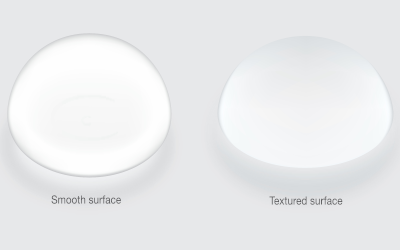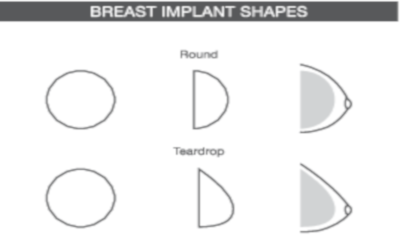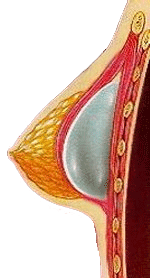Updated August 2018
Your breast augmentation journey begins with months of research; it can be headache-inducing. You have to make decisions about implant types, implant textures, implant fills and implant placement. It's a lot to take in. We understand, so we've created this painless guide that will allow you to quickly understand the many options you'll have to seriously consider down the road.
Breast implant textures: smooth vs. textured implantsBreast implants come in two textures: smooth and textured. Each serves a purpose and provide a different feel, and each come with their own pros and cons.

Textured breast implants
Textured breast implants were designed to help prevent capsular contracture. The idea is that the textured surface should disrupt the contractile forces around the implant.
Its special rough design is such that the implants, rather than moving freely in the breast pocket, adhere to the breast tissue. Since its use, the jury is out on whether textured implants actually lower the incidence of capsular contracture, as some studies found that it does while others have not.
What is clear is that this implant type helps stabilize implant position and prevents it from flipping over. This process of adherence is particularly useful with teardrop-shaped implants, as they need to be aligned properly within the breast tissue to keep from looking distorted or irregularly shaped.
But because textured implants are, well, textured and contain a thicker, grained outer shell, they can tend to look and feel firmer. Its adherence feature also means less natural movement, but less rippling. The tendency for rippling increases when the implant is placed above the muscle and the overlying tissue grabs the implant surface and tugs on it.
Smooth breast implants
Smooth implants are covered by a smooth outer shell, providing a softer, more natural look and feel than textured breast implants. It is sleek all around, giving it the ability to move freely in the breast pocket and without drag. This aids in natural movement of the breast tissues and implants, but has the potential to contribute to implant displacement, increasing the risk of bottoming out and lateral drift.
Smooth implants may contribute to more palpable or visible rippling under the skin. Placing the implant under the muscle and choosing an implant size that can fully be covered by your existing breast tissue can reduce the appearance of rippling.
Breast implant fillers: saline vs silicone implants
One of the biggest choices you'll have is breast implant types: saline or silicone. Discussing with your plastic surgeon the look and feel you are trying to achieve, as well as the concerns you have about implants, will help determine which best suits your needs.
Saline breast implants
Saline implants consist of an elastic silicone shell filled with a saline (salt water) solution similarly found in the human body. But because the shell has to be thick enough to contain the solution inside, saline implants tend to fill firmer than silicone implants, which are soft and squishy.
The shell surface of saline implants can be either smooth or textured, and the implant itself can vary in volume, shell thickness, profile, and shape. They are also expandable.
Saline implants have some major advantages over silicone implants. One major concern with most breast augmentation patients is the chance of rupture in either type of implant. When a breast implant ruptures, the outer shell of the implant is torn. This can be caused by physical trauma, capsular contracture, or complications from other medical procedures. A saline implant rupture is easy to detect, for the implant deflates and the results are seen almost immediately.
Silicone breast implants
Silicone implants have a durable, elastic silicone shell filled with silicone gel that mimics the feel of natural breast tissue. They come in round and teardrop (anatomical) shape, and in both smooth and textured shell surfaces. Because silicone implants have less rippling than saline implants and are softer to the touch, some doctors recommend them for slender women with less fat and breast tissue to hide the implant. However, almost any woman can consider silicone breast implants for their body.
Silicone implant ruptures are harder to detect. When a silicone implant ruptures, the breast often looks and feels the same because the silicone gel may leak into the surrounding areas of the breast without a visible difference. Patients will need an MRI to diagnose a silicone gel rupture.
Breast implant shapes: round vs teardrop implants
Do you want your breasts to look more natural or symmetrical? The answer to this and other questions will help you decide which breast implant shape is for you: round or teardrop (anatomical).

Round breast implants
Round breast implants are just that: round. If a round implant "turns" in the pocket, it still maintains its round and symmetrical shape, and will not cause any distortion in the breast’s appearance.
When placed on a flat surface, a rounded implant will have a flat bottom and a domed-shape top. When placed in the body, the round shape will settle into a shape similar to an anatomical implant.
Round breast implants provide a more voluminous look all around and come in a variety of sizes, dimensions, and profiles, making them able to fit a variety of body shapes and sizes. They may have smooth or textured surfaces—though the majority are smooth—and come in both saline and silicone. Smooth round implants are less expensive than round textured and teardrop implants because of their design.
Teardrop breast implants (anatomical implants)
Teardrop implants, also referred to as anatomical breast implants, were designed primarily for reconstruction purposes, but have since made their way into general breast augmentation. They are sloped at the top and bottom heavy below. This produces a more natural-looking breast compared to round implants. When looking at an anatomical implant from the front, it appears oval in shape. If viewed from the side, it appears to have more volume at the bottom, thus making it project in a more conical fashion.
All teardrop breast implants are textured with a rough surface. This causes the implant to stick to the tissue and resist movement so that the implant can retain its shape. If a shaped implant were to move and/or rotate within the pocket, its shape would become compromised, leaving the breast looking distorted.
Anatomical implants may require a larger incision because they are shaped and contain a firmer silicone. But, this implant type has more variations in shape; it is customizable by width, height, and projection.
Breast implant placement: under the muscle vs. over the muscle
Complete submuscular, partial submuscular and over the muscle are your three implant placement options. The thickness of your breast tissue along with the look and feel you want will help you and your plastic surgeon decide.
 Under the muscle
Under the muscle
The term under the muscle can be somewhat misleading as implants are not placed completely under the muscle. Rather, complete submuscular implant placement is when 2/3 of the implant is behind the pectoral muscles and serratus muscles, while 1/3 is behind the fascia (connective tissue that connects the pectoral, serratus and upper rectus abdominal muscles).
Though the implants are completely protected by the muscle, this placement type has the tendency to cause the implants to ride high. Complete submuscular placement is often reserved for patients with thin breast tissues, but any woman can have this placement as well.
With partial submuscular implant placement, 2/3 of the implant is covered by the pectoralis muscle, while 1/3 is covered by breast tissue only--the lower attachments of the pectoralis muscle to the rib cage are released. This has the benefit of allowing the implant to be protected by the muscle but sit in a more natural-looking position.
Some of the pros of these placements include a lower risk of rippling and capsular contracture, a more natural-looking appearance, and more visible mammograms. However, an implant behind the muscle has a longer recovery and settling time, and implant size is limited.
 Over the muscle
Over the muscle
An implant that’s over the muscle is in front of the muscle but behind the breast tissue. It provides for easier placement by your surgeon and has less recovery time as well as less post-op pain due to the muscles being left in tact.
With under-the-muscle placement, the muscle places pressure on the implant, reducing its size appearance by approximately 10 percent. When the implant is placed above the muscle, more cleavage is created.
While this placement option allows for a larger implant size—because the implant is not protected and harnessed by the thick pectoralis muscle—the risk of bottoming out rises. Women with thick breast tissue are therefore better suited for this placement.
Other cons include visible rippling, higher capsular contracture rate and a more augmented "fake" look.
Breast augmentation incisions
Incision site carries a lot of weight for women considering breast augmentation, mainly because it will determine how noticeable your breast augmentation scars are. Here are the four incision types you'll have to choose from:
Periareolar incision
The periareolar incision is made on the bottom edge of the areola, where the dark tissue meets the lighter breast tissue. This incision type is preferable to some surgeons who find it gives them better visibility to create the implant pocket. It also allows for breast implants to be removed and/or replaced more easily in the future.
This incision site can work for most women but tends to be best for patients who are also getting or considering a breast lift (mastopexy), since this procedure requires an incision around the nipple.
Disadvantages to this technique are the loss of nipple sensation from the sensory nerves being cut, the risk of bacteria exposure from the severed breast ducts, and potential complications with breastfeeding.
Transaxillary incision
The transaxillary incision calls for a cut to be made in the natural fold of the armpit. A channel to the breast is then made and a pocket is created behind the breast for the implant. While both saline and silicone implants can be used with this technique, most surgeons prefer saline, which is inserted as an empty shell and filled once the implant is in place. Silicone implant placement requires a bigger incision and makes the job of placement more challenging.
Women who choose this incision type do so because the breast augmentation scar is far from the breasts. Also, because the mammary gland is left in tact, they don't have to contend with things like loss of nipple sensation, bacteria exposure or complications with breastfeeding.
Inframammary incision
The inframammary incision is made in the fold, where the lower part of the breast meets the chest wall. Both saline and silicone breast implants can be inserted through here, either over or under the muscle.
Patients with naturally hanging breasts may choose this incision type because their lower breasts will cover the scar. For the surgeon, it allows for more control over bleeding, pocket creation, and implant placement. Like the periareolar incision, this incision can be reopened if additional surgeries are needed. But, unlike the periareolar incision, there is no risk of nerve damage to the nipples.
A major drawback, however, is if a woman decides to go up in size, the scar will likely migrate up. If she goes down in size, the scar will likely migrate down. In both cases, the scar can become visible.
Transumbilical incision
With the transumbilical incision, a small incision is made at the rim of the belly button. An endoscope is weaved up to the breast tissue and the tissue is loosened behind the breast. Once the pocket is made, each empty saline breast implant is rolled up and worked up to the breasts, where they are then placed and filled. Because of the small surgical space, only saline breast implants can be used for this incision type.
Above all, this incision site produces less scarring, less surgical time (approximately 45 minutes) and as a result less recovery time. But because the surgeon must work so far away from the breasts, it makes positioning the implants difficult. Also, should you require another breast surgery, the scar cannot be reopened and you'll be let with additional scars.
Breast implant sizes
While other sizes are available, the most common breast implant sizes are between 200cc and 850cc. The larger the breast implant, the greater its diameter and projection. Some surgeons consider a larger implant to be over 400cc. Doesn't sound like much, but when you consider you are adding this amount to your own breast tissue, you begin to see this cc as something greater.
Out of all the decisions women make regarding breast implants, size becomes the thing they fret over the most, especially the closer they get to surgery day. Am I going too small? Am I going too big? These are the questions they ask themselves, and they are big ones in our Q&A forum.
To get the best breast implant size, your surgeon will measure your breast width diameter (BWD) and recommend sizes that are right for you. From there, you can try on breast implant sizers that mimic those cc's. But note that sizers are only an approximation and if you have your implants placed under the muscle they will appear 10 percent smaller. Other aids include "goal photos" and 3D imaging software that helps you visualize what different sizes, shapes, and profiles will look like on your body.
Breast implant profiles

Breast implants come in low profile, moderate profile, moderate plus profile, high profile and extra full profile. High profiles typically have a narrower base, but project more. Low- to moderate-profiles have a wider base and project less.
Like sizes, your profile type will largely depend on your BWD. Women with wider breast bases aren't usually fit for high profile breast implants, which are narrow; and women with narrow breast bases may not be right for some lower profiles. Placing a narrow implant in a wide breast base or a wide implant in a narrow breast base can lead to implant malposition and revisionary surgery.
Want to know more?
It may not seem like it, but we've only given you a snapshot of breast implants—there is much more to learn. Take a break and when you're ready, dive back in.
One way our women learn about breast augmentation and breast implants in a fun, engaging way is through breast augmentation forums. Of course, board-certified plastic surgeons and reputable sites should be your major information sources, but in forums you find real women posing questions and answers many newbies never think of. Your mind will churn—in a good way.



